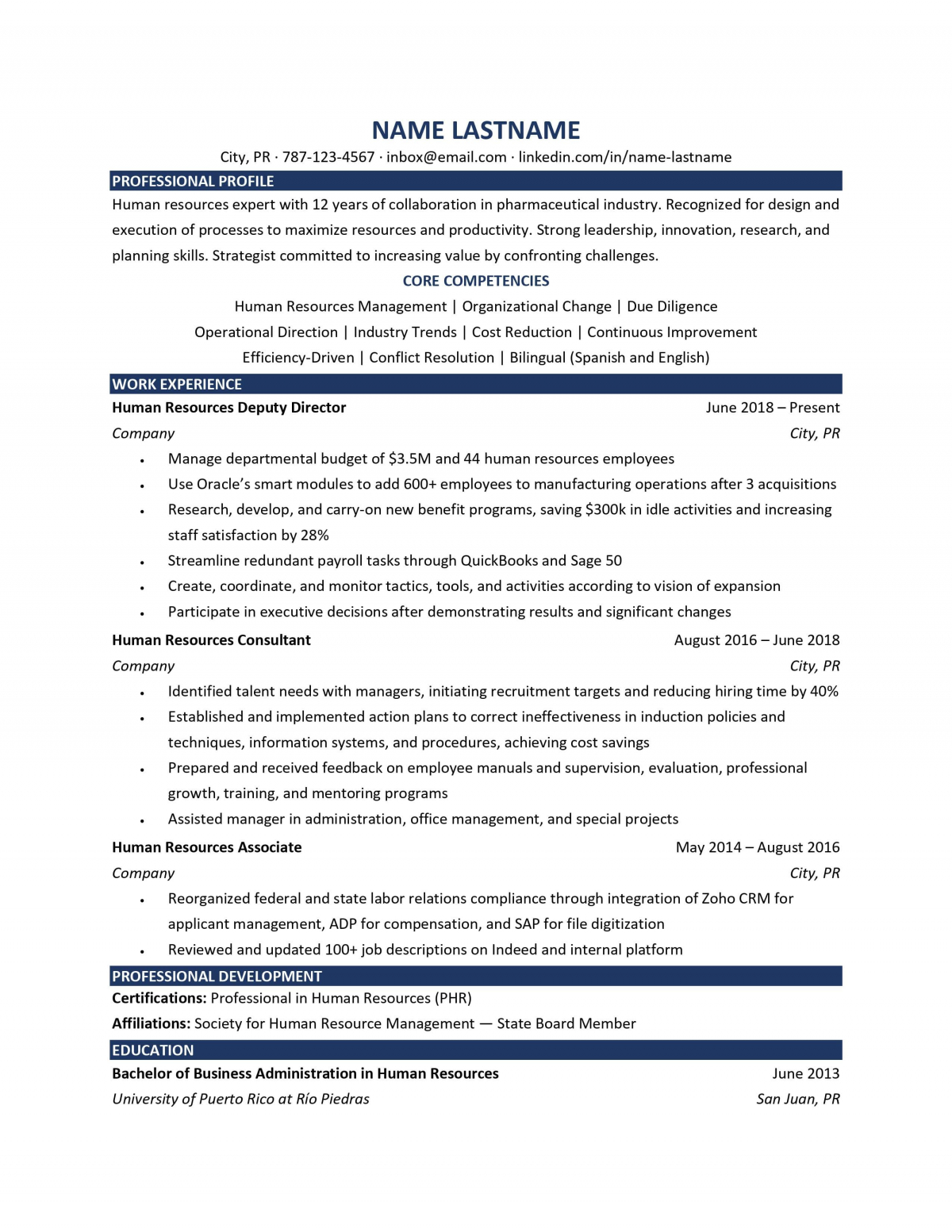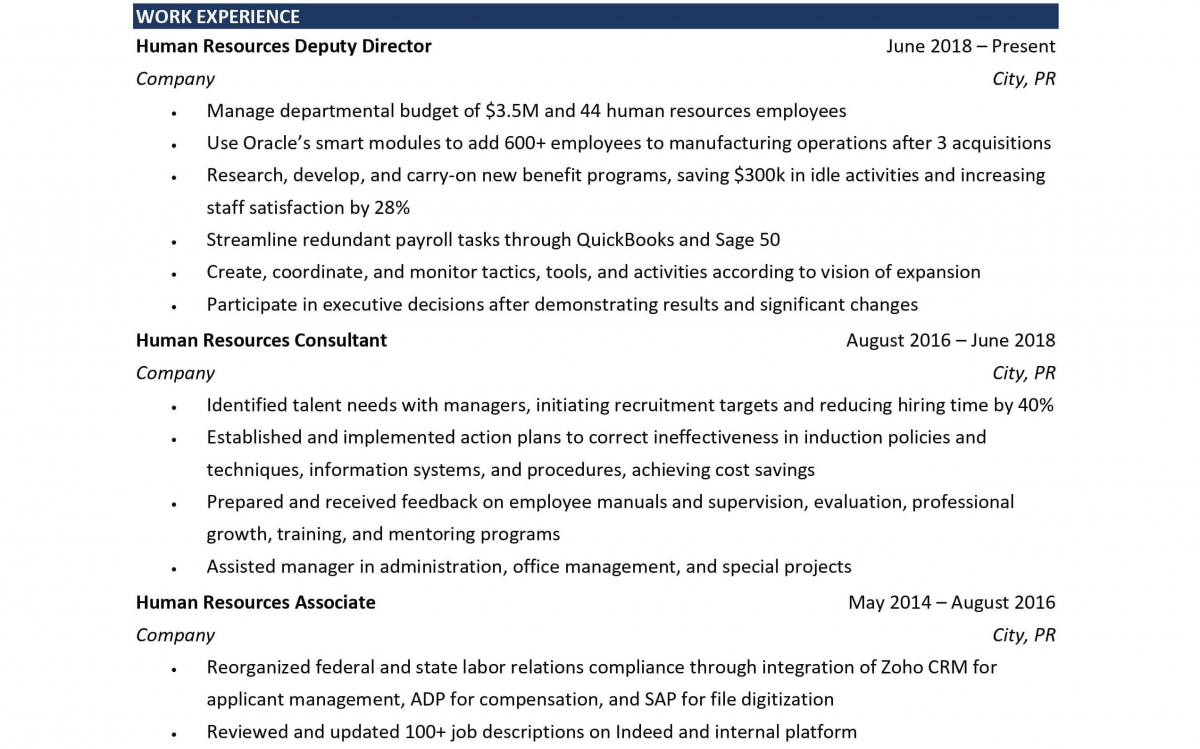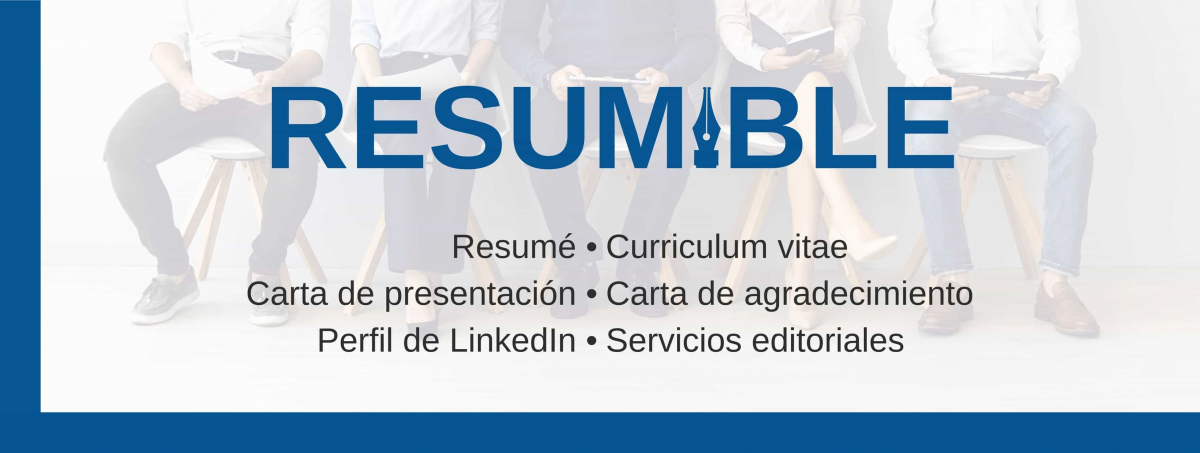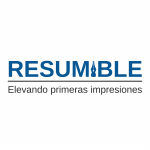Tabla de contenido
Undoubtedly, the competition to get a job is getting bigger and more challenging. Obtaining a simple job interview has become a task that requires a lot of effort. But do not fear. Resumible will direct you on how to overcome that first hurdle of putting together an impressive resume. This way, you will correctly communicate your qualifications and your value to a potential employer.

What is a Resume?
A resume is a document used by companies in the recruitment process and by candidates in their job search. It is the most powerful tool in your favor.
The first point you should know is that I recommend creating a chronological or traditional resume. From most recent to oldest, you present your work experience and academic background here. As you know, it is the most widely used and accepted format due to the ease of understanding the information.
In the following paragraphs, I discuss the sections that your resume should have. I use the example of a human resources professional who applied to a company that required a simple and short resume without sacrificing the quality of his contributions and main results.

Steps to Write a Resume
Contact Information
As expected, the first thing that your resume should include is your personal information. Your full name, city, phone number, and email address are all required. If you have a LinkedIn profile, portfolio, or electronic blog, you can also place the links. Make sure the information is up-to-date, as this is the method by which a company would communicate with you. It would be a shame if they did not get you because of this.
However, for jobs in the United States and Puerto Rico, never include photos or discriminatory information such as sex, age, religion, or political affiliations. As well, avoid offering personal data that could negatively influence the perception about you.

Professional Profile
Did you know that a resume is seen and evaluated by recruiters in less than 6 to 7 seconds? For that reason, you need to quickly capture their attention with a professional profile. Instead of a generic and basic objective (all candidates are looking for a job, right?), use this section, which you can also recognize by its titles of summary, background, or outstanding competencies.
I suggest using this proven formula: Mention your profession and years of experience. Indicate your recognized abilities or significant contributions. Finally, briefly explain your goals and why you specifically want to join the position at the company you are applying for. In this way, you appropriately show your value and what you bring to an organization.

Work Experience
You have already developed the first two main parts of your resume. At this moment, it is essential to talk about the most important section of building a resume: the work experience. Like I told you, start with your most current or most recent job. Each one must bear the title of the position, the company, the city, and the dates of employment.
After introducing the company, talk about your experience in the form of one- to two-line bullet points. Analyze the vacancy announcement for the position to apply for and show your most relevant functions. Do not keep talking only about your tasks. The most that a possible future employer wants to see are your contributions, results, and key accomplishments. They will know how well you understand your functions and how unique you are in comparison to the competition.
Remember: the more recent the job, the more you should talk about it, as it is surely more relevant. In your document, I recommend including the last three to four jobs, or 10 to 15 years.
Do not forget that a resume has to pass the filter of the applicant tracking systems or ATS. Not knowing how to face them can automatically rule out your candidacy, no matter how qualified you are. That is why you should use the keywords that you find in the announcement. For example, if the position requires budget monitoring and analysis skills, you should particularly mention those skills if you have acquired and executed them.
What should you do if you do not have the necessary skills or any experience? No problem. You can always apply for the position. You never know how far you will go if you do not try. Also, take advantage of other sections that we will present later.

Skills
I recommend you mention your skills through your experiences. This is how you demonstrate how you can apply them. However, if you have other skills that you want to highlight or do not know how to present, you can use this section. Some examples of these skills include languages, technological programs, and soft skills, among others.
Certifications and Licenses
Do you have professional credentials? Place them by mentioning the name of the certification, the educational or issuing institution, and the year of expiration or issuance. If requested by the vacancy, include the identification number.

Education
The presentation of your education is simple. You only need to include the academic degree or certificate, the university, the city, and the year of graduation.
As I mentioned, if you are a student, a recent graduate, or have little work experience, use this part to go in depth on what you have learned in your classes. It would also help to include special projects, extracurricular activities, GPA (if it was 3.50 or higher), and honors.
Many people overlook the fact that if you have a college degree, you do not have to include high school data. Use the resume space to your advantage.

Other Sections
Do you think you can still show more of yourself in other sections? Do not limit yourself to including that information. Other items that you can add to your resume include volunteer or community service, interests or hobbies, special awards, and publications, among others. The important thing is that it should be relevant.
Tips and Tricks
- Prepare your resume with safe margins and a common font in size 11 or 12.
- Keep your resume to no more than one page. If you are a manager, director, or executive, you can use up to two pages.
- Take advantage of styles and formatting like italics and bold. Highlight section titles for easier reading.
- Do not use images or include tables or columns. This is to make sure you meet the ATS requirements.
- Be consistent. To illustrate, if you include months or cities, do so for all experiences.
- Speak in the first person, but do not use pronouns (I, me, my).
- Use numbers to measure impact. In this way, you demonstrate evidence and results. For example, "Achieve sales target, exceeding 145% target and receiving annual recognition."
- Begin each line of your experience with powerful verbs.
- Do not write "I was responsible for..." but rather "Lead a team of 56 office employees..."
- Do not repeat functions in your jobs. A resume should be short, direct, and simple.
- Do not include references. Do not say that you have them available either, as that is implicit. However, I suggest that you have them for when they ask for them, mostly after an interview or job offer.
- Check your spelling and grammar carefully. A single mistake can leave a bad impression or make them think you do not care as much about the position.
- Save the file as a PDF. This is the recommended format for sending it by email. What should the file be called? Use this simple format: Name - Resume.
- Change the resume each time you apply. Each position has particular requirements that you must respond to appropriately. You can use the first resume you design and then appropriately change some details.
How to Send a Resume
Obviously, I recommend sending your resume with a cover letter. In this document, you indicate your intention to apply for the position, and you can include points that you do not know how to express in your resume. Did you know that accompanying this letter increases your chances of consideration? Now you will understand its importance, and you will want to create it.

Resumible

Are you interested in positions in the federal government? Then you must create a federal resume, which I can also help you with. Do you want to enter the academic, research, legal, or medical fields? Use a curriculum vitae (CV). These two types of documents are different from a regular resume and require more detail.
Now you know how to make a resume. If you need a review, evaluation, or optimized professional resume writing services, do not hesitate to contact me at resumible.com. Also, you can reach me by WhatsApp at 787-482-8245.

